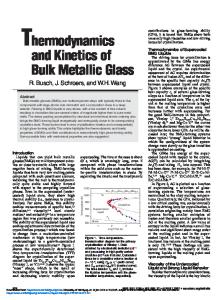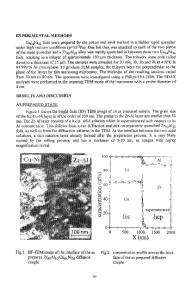High-Pressure Equation of the State of a Zirconium-Based Bulk Metallic Glass
- PDF / 426,755 Bytes
- 8 Pages / 593.972 x 792 pts Page_size
- 54 Downloads / 339 Views
INTRODUCTION
BULK metallic glasses (BMGs) are a recently developed class of materials exhibiting unique properties including very high strength and plastic properties that vary greatly from those of crystalline materials. The BMGs do not strain harden; their plastic deformation response is influenced by both shear and normal stresses, and it occurs inhomogeneously through plastic strains concentrated in localized shear bands.[1] Because of these unique characteristics, BMGs have been a subject of interest in many studies. It is known that BMGs crystallize with the addition of thermal energy, but the phenomenon of stress-induced crystallization in BMGs has also been investigated in a few studies. Stress-induced nanocrystallization of BMGs has been observed by Kim et al.[2] and Boucharat et al.[3] using nanoindentation and high-stress (6 GPa) torsion straining, respectively. Kim et al.[2] described M. MARTIN, Graduate Research Assistant, and N.N. THADHANI, Professor and Associate Chair, are with the School of Materials Science and Engineering and the Woodruff School of Mechanical Engineering, Georgia Institute of Technology, Atlanta, GA 30332, USA. Contact e-mail: [email protected] T. SEKINE and T. KOBAYASHI, Scientists, are with the Advanced Materials Laboratory, National Institute for Materials Science, Tsukuba 305-0044, Japan. L. KECSKES, Acting Team Leader, is with the Weapons and Materials Research Directorate, U.S. Army Research Laboratory, AMSRD-ARL-WM-MB, Aberdeen Proving Ground, MD 21005-5069, USA. This article is based on a presentation made in the symposium entitled ‘‘Dynamic Behavior of Materials,’’ which occurred during the TMS Annual Meeting and Exhibition, February 25–March 1, 2007 in Orlando, Florida, under the auspices of The Minerals, Metals and Materials Society, TMS Structural Materials Division, and TMS/ASM Mechanical Behavior of Materials Committee. Article published online August 9, 2007 METALLURGICAL AND MATERIALS TRANSACTIONS A
this phenomenon as a consequence of flow dilatation in shear bands and radically enhanced diffusional mobility. The nanocrystals observed by Boucharat et al.[3] were observed to appear predominantly in the shear bands, but also in the surrounding amorphous matrix, which is an indication that there is another process besides enhanced mobility within the shear bands that is contributing to deformation-induced crystallization. The phenomenon of stress-induced crystallization in BMGs has not been previously investigated at high stresses (above 6 GPa). The current work sought to investigate the phase stability and possibility of stressinduced crystallization in a BMG at high stresses. The high-strain-rate behavior of BMGs and their composites has been investigated in some detail,[4–16] but few studies have been conducted to investigate the highstress equation of state (EOS), phase stability behavior, and shock wave response of monolithic BMGs. The shock wave response of Zr41.2Ti13.8Cu12.5Ni10Be22.5 (LM1) has been investigated by Zhuang et al.[17] up to stresses of
Data Loading...











